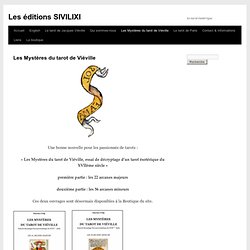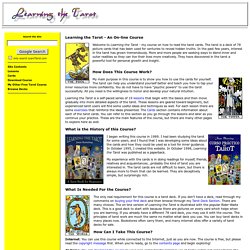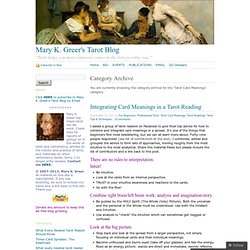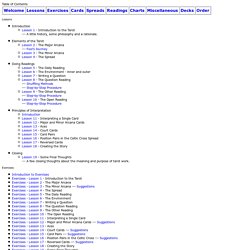

Les Secrets du Tarot. Les Arcanes majeurs - A. JODOROWSKY. Les Mystères du tarot de Viéville. Une bonne nouvelle pour les passionnés de tarots : « Les Mystères du tarot de Viéville, essai de décryptage d’un tarot ésotérique du XVIIème siècle » première partie : les 22 arcanes majeurs deuxième partie : les 56 arcanes mineurs Ces deux ouvrages sont désormais disponibles à la Boutique du site.

Texte de présentation de la quatrième de couverture de la 1ère partie de l’ouvrage : A travers une étude minutieuse, l’auteur nous fait découvrir un tarot du XVIIème siècle, le tarot de Viéville. L’analyse fine des détails nous dévoile un monde caché, fait de double ou triple sens, fourmillant d’un bestiaire dissimulé en images subliminales où loups, serpents, cygne, agneau et bien d’autres animaux encore, nous informent sur la nature profonde des protagonistes du tarot. Texte de présentation de la quatrième de couverture de la 2ème partie de l’ouvrage : Afin d’illustrer le propos voici quelques extraits choisis tirés de la première partie consacrée aux arcanes majeurs. « Le double carré « Le Phénix. Tarot de Marseille et Taijitu (Yin/Yang) - Axel Addington - Développement personnel. Enchaînement X - XI - XII - XIII - XIIIIsous des volutes d’encens.

On l’a souvent dit et répété : le tarot fait référence à des archétypes. Par définition, ces archétypes sont universels et transcendent le temps et l’espace. Je te propose ici une réflexion sur l’enchaînement X - XI - XII - XIII - XIIII mis en parallèle avec le symbole YIN_YANG. Deux cultures, deux représentations, deux visions : avec quelles con/divergences ? Seul un eurasien, peut-être, pouvait tenter l’exercice :) Petit rappel sur le YIN et le YANG. . $1Pour en savoir plus, laisse-moi te recommander JAVARY, Cyrille J.
X La Sphinge de X 2renvoie à la question duqui suis-je? X > XI Pour passer de X en XI, il nous faut un coup de I_Bateleur [X + I = XI]. Learning the Tarot - An On-Line Course. Learning the Tarot - An On-line Course Welcome to Learning the Tarot - my course on how to read the tarot cards.

The tarot is a deck of 78 picture cards that has been used for centuries to reveal hidden truths. In the past few years, interest in the tarot has grown tremendously. More and more people are seeking ways to blend inner and outer realities so they can live their lives more creatively. They have discovered in the tarot a powerful tool for personal growth and insight. How Does This Course Work? My main purpose in this course is to show you how to use the cards for yourself. Learning the Tarot is a self-paced series of 19 lessons that begin with the basics and then move gradually into more detailed aspects of the tarot. What is the History of this Course? I began writing this course in 1989. My experience with the cards is in doing readings for myself, friends, relatives and acquaintances...probably the kind of tarot you are interested in. What Is Needed For the Course? Tarot Spreads. Mary K. Greer's Tarot Blog. I am delighted to provide this previously unpublished text, which is from a hand-copied manuscript of Sub Spe [John Brodie Innes] I apologize to those who will find many of the references difficult, but the information can help greatly in understanding the Golden Dawn approach to the Minor Arcana and also the Rider-Waite-Smith and Crowley’s Thoth decks.

A glossary of Golden Dawn terms is available at The Hermetic Order of the Golden Dawn website (click on H.O.G.D. Dictionary in the directory). General Scheme: The Breath of God passes down through the Four Worlds of the Qabalah from the purely Spiritual to the absolutely material. In each world there is a Tree of Life and the Breath passes down from Sephira to Sephira from Kether to Malkuth and thence to the Kether of the new lower World.
[The results and names of the cards are arrived at by combining the meanings of the numbers, with the meanings of the suits and interpreting by the Kabbalah. Meaning of Numbers: 3. produces the Prince. Pythagorean Tarot. Tarot Course Table of Contents. Table of Contents Lessons Introduction Lesson 1 - Introduction to the Tarot --- A little history, some philosophy and a rationale.

Elements of the Tarot Lesson 2 - The Major Arcana --- Fool's JourneyLesson 3 - The Minor Arcana Lesson 4 - The Spread Doing Readings Principles of Interpretation IntroductionLesson 11 - Interpreting a Single CardLesson 12 - Major and Minor Arcana Cards Lesson 13 - Aces Lesson 14 - Court Cards Lesson 15 - Card Pairs Lesson 16 - Position Pairs in the Celtic Cross Spread Lesson 17 - Reversed Cards Lesson 18 - Creating the Story Closing Lesson 19 - Some Final Thoughts --- A few closing thoughts about the meaning and purpose of tarot work. Exercises Card Information Pages Spread Information Pages Sample Readings Charts Miscellaneous [ Home ] [ Course ] [ Cards ] [ Decks ]